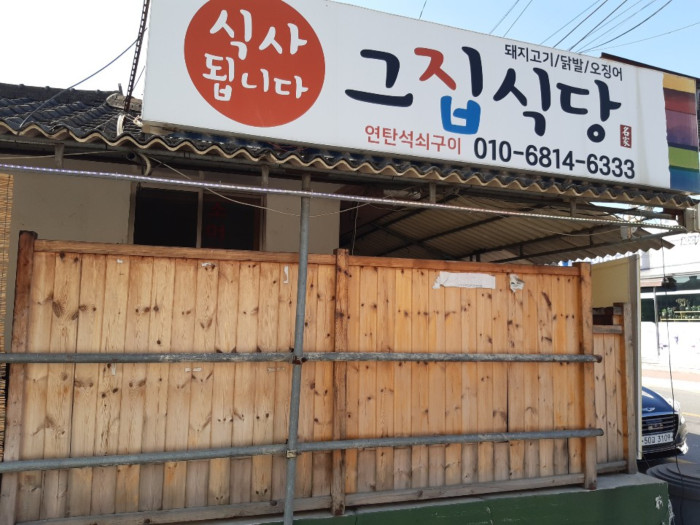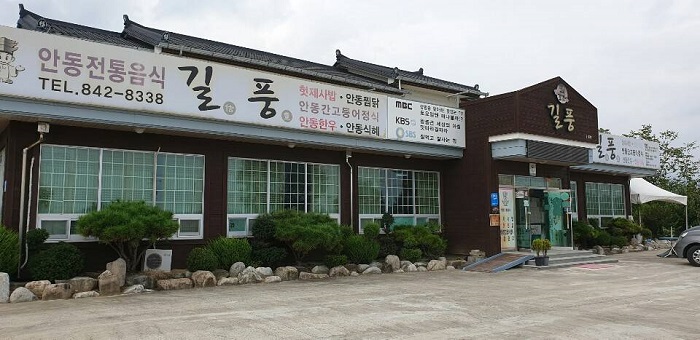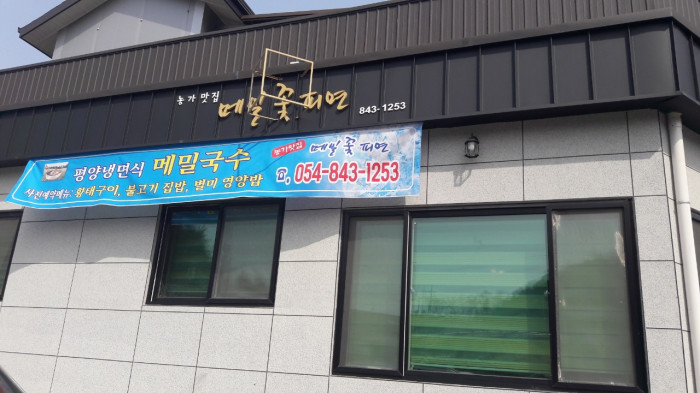Dawoo Motel [Korea Quality] / 다우모텔 [한국관광 품질인증/Korea Quality]
14.5Km 1 2023-04-13
66, Jangteojungang-gil, Andong-si, Gyeongsangbuk-do
+82-54-858-9100
Dawoo Motel is located in a lively street located in Pungsan-eup, Andong-si, and serves as a popular accommodation for visitors to Hahoe Village thanks to its affordable rates.
The five-story building houses 25 rooms, with the maximum occupancy of 50. The rooms are available in both Korean and bedroom styles. Bedrooms, which have beds and sofas, have a standard occupancy of 2 and a maximum of 3, while the twin room has a maximum occupancy of 4. Korean rooms have a standard occupancy of 2, but various ondol (under-the-floor heating system) rooms can house up to 5, 6, and 7 guests. Dawoo Motel thoughtfully requires no additional surcharge for additional guests in ondol rooms.
Not all rooms have bathtubs, so guests are advised to contact the front desk for their reservation. Guests are offered complimentary bottled water, beverages, and coffee. All rooms are furnished with TV, refrigerator, air conditioning, towels, basic toiletries, and hair dryer. Pets are allowed in the room, and services are also offered in English. Hahoe Village and Byeongsanseowon Confucian Academy, which were inscribed as UNESCO World Heritage, can be reached by car in 20 min.
Geujip Sikdang (그집식당)
14.6Km 128 2021-04-13
2, Yeokjeon 1-gil, Andong-si, Gyeongsangbuk-do
+82-54-841-3331
It is a place where you can enjoy various Korean side dishes. This restaurant's signature menu is kimchi stew. This Korean dishes restaurant is located in Andong-si, Gyeongsangbuk-do.
Gilpung (길풍)
15.8Km 45 2021-03-23
8, Nabau-gil, Andong-si, Gyeongsangbuk-do
+82-54-841-9967
It is a clean and delicious restaurant, selected by the Korea Tourism Organization, where you can taste Andong's local food. This restaurant's signature menu is Andong braised chicken. This Korean dishes restaurant is located in Andong-si, Gyeongsangbuk-do.
Songgyehyeon [Korea Quality] / 송계헌 [한국관광 품질인증/Korea Quality]
15.8Km 0 2021-03-25
332, Byeongsan-gil, Andong-si, Gyeongsangbuk-do
This hanok (traditional Korean House) lies only 500 m away from Andong’s Byeongsanseowon Confucian Academy. Byeongsanseowon Confucian Academy is one of the Confucian academies (Joseon-era places of learning and veneration of Confucian scholars) registered as a UNESCO World Heritage, and is particularly known for its beautiful harmony with the surrounding nature. Songgyehyeon likewise faces the Nakdonggang River to the front, and a 330 m-high mountain to the back, displaying the characteristic harmony of hanok with nature.
The house was named Songgyehyeon by the owner, who wanted to build a house made out of pine trees (“song”). The entire house is offered for rent, which makes it ideal for families and groups. Songgyeheon follows a strictly traditional structure of hanok, as evident in its hipped-and-gable roof, but its interior is equipped with comfortable modern facilities. The house includes both bedrooms and Korean-style ondol (under-the-heating system) rooms. One of the three bedrooms available has a queen-sized bed, while the remaining two are equipped with comfortable mats. The common space, spacious enough to host a group, has a high ceiling dominated by exposed beams. The kitchen is equipped with cooking equipment like refrigerator, gas stove, microwave oven, and utensils for guests to cook their own food. The owner of the house also enthusiastically provides detailed information on Andong’s many tourist sites.
Andong Hanji (안동한지체험)
15.8Km 4988 2019-04-10
36-1, Sosan-ri, Pungsan-eup, Andong-si, Gyeongsangbuk-do
+82-54-858-7007
Andong Hanji, situé à l’entrée du village Hahoe, zone préservant la tradition et la coutume coréenne, a fait de son mieux pour fabriquer du papier traditionnel coréen. Le papier coréen d’Andong est fait à partir de papier de bois de mûrier coréen et d’eau pure. Andong Hanji est très fière de maintenir une qualité exceptionnelle et la plus haute capacité de production de papier traditionnel coréen.
* Produits
Approximativement 60 papiers différents incluant du papier à dessin fait de pulpe de mûre, du papier à calligraphie, du papier à dessin basique, du papier fenêtre, du Jungji (papier), de l’Unyongji (papier), du Piji (papier) pour papier peint, du papier coréen à multiples épaisseurs, du papier pour sol, du papier à livre, du papier brocardé pour les intérieurs de première qualité, du numéro 100 et 120 pour les peintres professionnels, et du papier couleur coréen utilisé pour l’artisanat ainsi que du papier d’emballage sont fabriqués ici.
* Réception du papier coréen
Le papier traditionnel coréen de haute qualité est fourni comme suit : le papier à dessin à la seconde grotte Seokguram dans le temple Donghwasa, le Samyukji (papier) au temple Bulguksa à Gyeongju, le « papier de peinture orientale » à la faculté des Beaux-Arts d’Andong National University, l’Oebalbaekdaksunji (papier) à l’Institut de Recherche pour la Préservation des Propriétés Culturelles du Papier, et le Baekdaksunji (papier) au Centre de Conservation Jung-Jae. Présentement, les diplômes d’honneur et les lettres de nomination sont fournies à l’Agence Nationale de Police.
Daebanggwangbulhwaeomgyeong (soutra Avatamsaka) (Trésor National 196) – retranscrit sur du papier de la periode de Silla Unifié, aussi utilisé pour le Mugujeonggwan Daedaranigyeong (soutra Dharani de pure lumière), affiché au musée d’Arts Ho-Am, a été restauré ici. En décembre 2001, le soutra restauré a été fourni à l’Administration de l’Héritage Culturel de Daejeon. En outre, des poupées de papier de mûre et des images faites de papier coréen traditionnel sont affichées dans la salle VIP de Korean Air à l’aéroport international d’Incheon.
Ecole confucianiste de Byeongsanseowon [Patrimoine Mondial de l'UNESCO] (병산서원)
16.2Km 3514 2022-12-30
30, Byeongsan-ri, Pungcheon-myeon, Andong-si, Gyeongsangbuk-do
82-54-858-5929
Byeongsan Seowon est une école fondée par des savants confucianistes coréens en hommage à Yu Seong-Ryong (1542-1607), célèbre érudit qui jouissait d’une très haute réputation pour sa vertu et ses savoirs. Actuellement, cet établissement abrite sa plaque commémorative.
En 1863, le roi de la dynastie Joseon a doté cet établissement d’une autorité en tant que Saek Seowon, école exempte de toute taxe et de tout labeur en lui fournissant une plaque écrite par le roi, des livres, un terrain et des esclaves.
En 1868, un décret de Heungseon Daewongun (1820-1898, politicien de la famille royale de la dynastie Joseon) a aboli les écoles confucéennes ; Byeongsan Seowon est un des 47 établissements de ce type dans toute la Corée du Sud, et un des deux dans la ville d’Andong, à avoir pu y échapper.
Située devant le fleuve Nakdong et entourée par la montagne Byeonsan comme d’un paravent, cette école offre un très joli paysage.
Jeongjae Head House [Korea Quality] / 정재종택 [한국관광 품질인증]
16.3Km 7775 2023-04-13
경상북도 안동시 임동면 경동로 2661-8
+82-10-8590-0625
Boasting more than 300 years of tradition, Jeongjae Traditional House is the head house of Ryu Chi-myeong (pen-name: Jeongjae), who inherited the study of Togye Yi Hwang (1501-1570), one of the two most prominent Korean Confucian scholars of Joseon. The old house features the characteristic construction elements of a Joseon hanok, including the stylobate, wooden pillars, toenmaru (the narrow wooden porch running along the outside of the building), tiled roof, and other structures, and commands an open view of Imha Lake. The house was originally built by Ryu Gwan-hyeon, the great-great-grandfather of Ryu Chi-myeong, in 1735 (the 11th year of the reign of King Yeongjo of Joseon) in the village of Handeul in Imdong-myeon, Andong-si, Gyeongsangbuk-do, but it was relocated to the foot of Guamsan Mountain in 1987 when Imha Dam was built and the surrounding area was submerged as a result. The house consists of the daemunchae (gate building), jeongchim (a ‘ㅁ’-shaped house with a tiled roof), haengnangchae (servants’ quarters), a shrine, and a pavilion. The sarangchae (men’s quarters) is clearly visible, while the anchae (women’s quarters) is concealed within the house. The sarangchae has a sarangmaru (wooden floor), a large sarangbang room, a small sarangbang room, and there is a small maru between the two rooms. The buildings of the sarangchae and anchae are clearly divided into segregated spaces for men and women according to Confucian tradition. The anchae has a daecheongmaru (large wooden floor) in the middle; a main room, kitchen, and toilet on the right; and a numaru (upper floor) and sangbang (upper room) on the left. The small side door of the main gate links to the door by which to enter the anchae, which has a small vegetable garden. Manujeong Pavilion (Gyeongsangbuk-do Cultural Heritage Material No. 37) is a half-hipped roof building with single-layered eaves located on the left side of the house outside the main gate. It is the place where Ryu Chi-myeong used to teach his students, and consists of a large maru and a guest room. The pavilion is also surrounded by the beautiful scenery of Imha Lake, mountains, and chestnut trees. Jeongjae Traditional House provides two special experience programs: Making Songhwaju, which is the Ryu family’s home-brewed liquor (15 to 18 degrees) made with rice, glutinous rice, yeast, pine needles, and chrysanthemums, led by the owner’s wife (Intangible Cultural Asset No. 20); and Making Tarak, which is a fermented milk drink that has been made by the Ryu’s family for some 500 years. As the recipe for making Tarak is relatively simple, and uses yeast that is usually used to make raw rice wine like Makgeolli, people can easily make it at home. The house also runs a traditional music program designed to show participants how to play the gayageum (Korean zither with twelve strings) and sing Korean folk songs, and stages small concerts.
Memilkkot Pimyeon (메밀꽃피면)
16.3Km 77 2021-03-26
22, Seonseong 4-gil, Andong-si, Gyeongsangbuk-do
+82-54-843-1253
It is a place where the directly made soba noodles and thick broth are excellent. The best menu at this restaurant is buckwheat noodles. This Korean dishes restaurant is located in Andong-si, Gyeongsangbuk-do.
Chemin maritime Sunseong Susang-gil (선성수상길)
16.6Km 0 2024-07-08
14, Seonseong-gil, Dosan-myeon, Andong-si, Gyeongsangbuk-do
Le chemin maritime Sunseong Susang-gil désigne un chemin d'1km qui relie le complexe culturel Sunseonghyeon avec le parc du lac d'Andong. Ce chemin, qui flotte sur l'eau, donne l'impression de pouvoir marcher sur l'eau.
Yekki Maeul (예끼마을)
16.6Km 0 2024-07-08
14, Seonseong-gil, Dosan-myeon, Andong-si, Gyeongsangbuk-do
Le village Yekki est un village artistique à Andong. Les alllées du villages sont décorées avec des peintures murales réalisées par des artistes locaux. Le principal charme du village est le chemin de l'eau Sunseong Susang-gil, un chemin de promenade sur l'eau.
![Dawoo Motel [Korea Quality] / 다우모텔 [한국관광 품질인증/Korea Quality]](http://tong.visitkorea.or.kr/cms/resource/01/2709201_image2_1.jpg)


![Songgyehyeon [Korea Quality] / 송계헌 [한국관광 품질인증/Korea Quality]](http://tong.visitkorea.or.kr/cms/resource/42/2706142_image2_1.jpg)

![Jeongjae Head House [Korea Quality] / 정재종택 [한국관광 품질인증]](http://tong.visitkorea.or.kr/cms/resource/96/2579496_image2_1.jpg)

 Français
Français
 한국어
한국어 English
English 日本語
日本語 中文(简体)
中文(简体) Deutsch
Deutsch Español
Español Русский
Русский